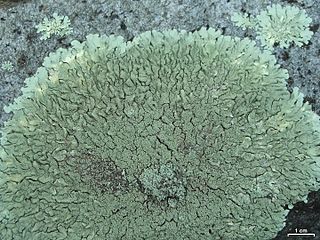
Elias Magnus Fries was a Swedish mycologist and botanist. He is sometimes called the "Linnaeus of Mycology". In his works he described and assigned botanical names to hundreds of fungus and lichen species, many of which remain authoritative today.

Parmelia is a genus of medium to large foliose (leafy) lichens. It has a global distribution, extending from the Arctic to the Antarctic continent but concentrated in temperate regions. There are about 40 species in Parmelia. In recent decades, the once large genus Parmelia has been divided into a number of smaller genera according to thallus morphology and phylogenetic relatedness.

The Parmeliaceae is a large and diverse family of Lecanoromycetes. With over 2700 species in 71 genera, it is the largest family of lichen-forming fungi. The most speciose genera in the family are the well-known groups: Xanthoparmelia, Usnea, Parmotrema, and Hypotrachyna.
William Alfred Weber was an American botanist and lichenologist. He was Professor Emeritus at the University of Colorado at Boulder and former curator of the University of Colorado Museum Herbarium.

Irwin Murray Brodo is an emeritus scientist at the Canadian Museum of Nature, in Ottawa, Ontario, Canada. He is an authority on the identification and biology of lichens.

Melanohalea is a genus of foliose lichens in the family Parmeliaceae. It contains 30 mostly Northern Hemisphere species that grow on bark or on wood. The genus is characterised by the presence of pseudocyphellae, usually on warts or on the tips of isidia, a non-pored epicortex and a medulla containing depsidones or lacking secondary metabolites. Melanohalea was circumscribed in 2004 as a segregate of the morphologically similar genus Melanelia, which was created in 1978 for certain brown Parmelia species. The methods used to estimate the evolutionary history of Melanohalea suggest that its diversification primarily occurred during the Miocene and Pliocene epochs.

Melanelixia is a genus of foliose lichens in the family Parmeliaceae. It contains 15 Northern Hemisphere species that grow on bark or on wood. The genus is characterized by a pored or fenestrate epicortex, and the production of lecanoric acid as the primary chemical constituent of the medulla. Melanelixia was circumscribed in 2004 as a segregate of the related genus Melanelia.

Xanthoparmelia is a genus of foliose lichens in the family Parmeliaceae. This genus of lichen is commonly found in the United States, South America, southern Africa, Europe, Australia, and New Zealand.
Aino Marjatta Henssen, was a German lichenologist and systematist. Her father, Gottfried Henssen, was a folklorist and her mother was Finnish.

André Aptroot is a Dutch mycologist and lichenologist. His primary research focus is on biodiversity, particularly tropical lichens, encompassing systematics, floristic surveys, and taxonomic reviews. A prolific researcher, he has published more than 500 scientific papers and described hundreds of new fungal and lichen species.
Mason Ellsworth Hale, Jr. was one of the most prolific American lichenologists of the 20th century. Many of his scholarly articles focused on the taxonomy of the family Parmeliaceae. Hale was one of the first lichen experts to incorporate secondary chemistry and technology such as computers and scanning electron microscopy into taxonomic work. Mason Hale published approximately two hundred articles and books on various aspects of lichen biology including taxonomy, anatomy, chemistry, and ecology. Hale also wrote several books aimed at education and increasing accessibility to lichens.

Yasuhiko Asahina was a Japanese chemist and lichenologist.
Remototrachyna is a genus of foliose lichens in the large family Parmeliaceae. It was separated from the genus Hypotrachyna based on the structure of the excipulum and genetic differences.
Austromelanelixia is a genus of five species of foliose lichens in the family Parmeliaceae. All species are found in the Southern Hemisphere.
Rolf Santesson (1916–2013) was a Swedish lichenologist and university lecturer. He was awarded the Acharius Medal in 1992 for his lifetime contributions to lichenology.
Thomas Hawkes Nash III is an American lichenologist. His research is about the biology and ecology of lichens, and the effects of air pollution on plants and lichens. He is known as an authority on the family Parmeliaceae. During his long career at the Arizona State University, he helped develop the lichen herbarium into a world-class collection with over 100,000 specimens representing more than 5000 species. In 2010, the year of his retirement, he was awarded the Acharius Medal for lifetime achievements in lichenology, and the following year had a Festschrift published in his honor.
Rex Bertram Filson is an Australian lichenologist who made major contributions to knowledge of lichens in Australia and Antarctica.
Klaus Kalb is a German lichenologist and an authority on tropical lichens. Born in Nuremberg, he studied at the University of Erlangen–Nuremberg before pursuing a career that significantly advanced the field of lichenology, particularly in Brazil. Kalb's work in São Paulo from 1978 to 1981 led to a collaboration with Brazilian lichenologist Marcelo Pinto Marcelli, which is considered a model for non-commercial benefit-sharing in taxonomic research. He later became an associate professor at the University of Regensburg and is known for editing the exsiccata series Lichenes Neotropici. Kalb's contributions to lichenology include over 120 scientific publications, the description of numerous new species, and the development of a substantial lichen collection. His work has been recognised through various honours, including four lichen genera and numerous species named after him, as well as a Festschrift published in 2007 to mark his retirement.

Robert Lücking is a German lichenologist, known for his extensive research on foliicolous lichens and his significant contributions to the taxonomy, ecology, and biodiversity of fungi and lichens. He earned his master's and PhD from the University of Ulm, focusing on foliicolous lichens. He has received numerous awards for his work, including the Mason E. Hale Award for his doctoral thesis, the Augustin Pyramus de Candolle prize for his monograph, and the Tuckerman Award twice for his publications in the scientific journal The Bryologist.









